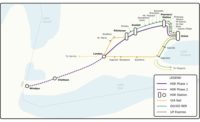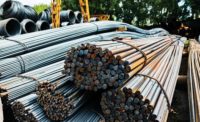Construction prices are still going up in Canada, but the upward momentum has slowed on the heels of a deal between Ottawa and Washington, D.C., to scrap tariffs on steel and aluminum. The levies, 25% on steel and 10% on aluminum, helped push up construction prices in Toronto by as much as 8% last year, with sizeable increases also in Montreal, Vancouver and Ottawa.
But even with the end of tariffs in May, other issues—including a booming construction market, worker shortages and a multibillion-dollar federal infrastructure program kicking into gear—will likely keep up pressure on costs, experts say.
“Last year when the tariffs hit, we started to see almost immediately the spikes in construction costs,” says Gerard McCabe, Canada managing director at global cost consulting firm Turner & Townsend. Ten of the country’s top 11 metro markets saw cost increases.
Over the past year, non-residential construction prices have jumped 4.8% across the country—led by Ottawa, which saw a 7% increase and Vancouver, where prices rose 6%—according to data from Statistics Canada, the national statistics agency (see chart).
Cities in western Canada’s oil-and-gas regions, hit hard by slumping prices in recent years, saw more tempered hikes. Turner & Townsend pegged hikes at 5% to 8% across key Canada metro markets, compared to a more typical 3% to 4%.
British Columbia contractors say they were especially affected by tariffs since construction there depends heavily on U.S. and foreign steel, especially for infrastructure, where shipping domestic steel across Canada by rail or truck is too costly, according to ConstructConnect’s Daily Commercial News.
|
Related Link |
Tariffs had the biggest impact on steel beams and bars, driving up prices to 25% from 15%. “We saw spikes in the cost of steel,” McCabe says. In place for more than 18 months before ending, tariffs had a big impact on project planning. “Uncertainty caused the majority of the pain for most contractors and suppliers,” he says.
Even before the tariff ended, prices had begun to stabilize in 2019 compared to the sticker shock last year. Construction prices across Canada rose .8% in the first quarter, but that was down from a 1.1% hike in the fourth quarter, according to Statistics Canada.
While further steel and aluminum price spikes are no longer a concern, project owners and contractors are unlikely to see costs for these critical materials return to pre-tariff levels “until the supply … catches up and/or the level of construction activity starts to reduce, says McCabe.
For now, there is no sign of a slowdown in Canada construction activity, especially in top metro markets, where billions in condo towers and mixed-use development is underway. Oxford Properties on June 26 unveiled a $2.7-billion plan to remake Toronto’s skyline, with 58- and 48-story towers that will include 800 apartments and 200,000 sq ft of retail.
Amid a booming market, project owners and contractors are running up against labor shortages as well as higher material costs. There is a particularly acute shortage of skilled craftworkers and the contractors to hire them in the fastest-growing markets, McCabe says. “The biggest driver for construction costs is volume and the availability of resources capable of delivering [it],” he says.
While an irritant, tariffs were not a market-breaker for design firms, says John Gamble, CEO of the Association of Consulting Engineering Companies/Canada. “There was upward pressure on materials, and tariffs probably put a little gasoline on the fire,” he notes.
Gamble sees new potential for construction-cost pressure as the Trudeau government’s $147-billion infrastructure plan finally kicks into gear. Much of the spending is backloaded into later years, which may require streamlining to avoid more upward price pressures, he says. “We are starting to see movement,” Gamble contends. “I don’t think we are at the point where it is a seller’s market yet—that may come.”






Post a comment to this article
Report Abusive Comment